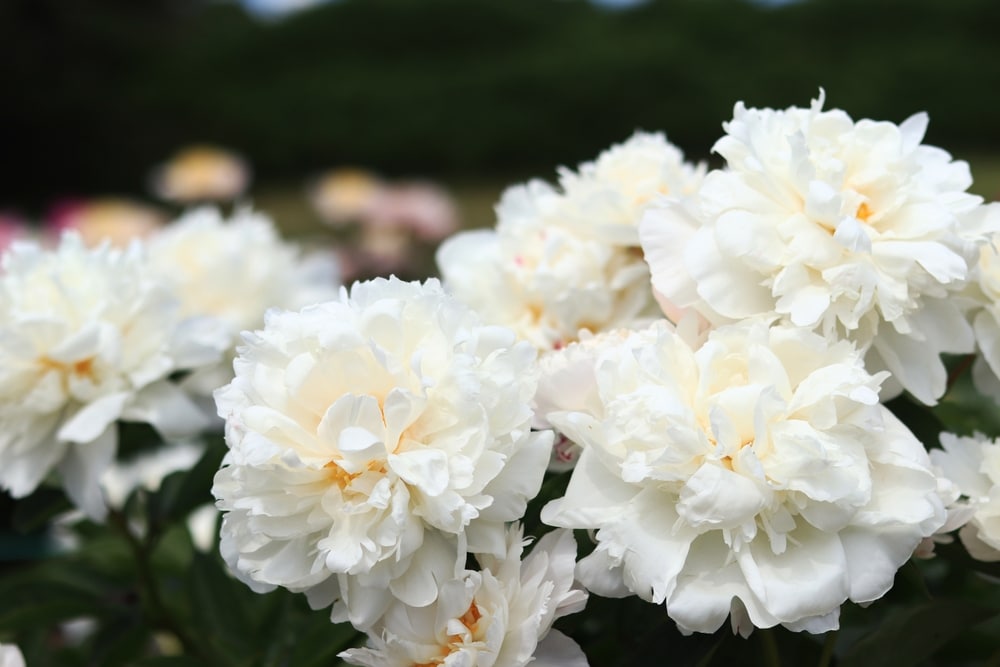Color is a goal for many gardeners.
If you are in that camp and have perhaps previously overlooked white varieties of your favorites, there are plenty of reasons to reconsider.
Even if you don’t aspire to create a dedicated white garden (sometimes known as a moon garden because of the special way white flowers reflect moonlight), there are several beautiful white perennial varieties you will want to consider adding to your growing repertoire.
Though a few perennial plants will bloom all season long, it’s more common for perennials to bloom during a specific window.
When you plant several varieties, you’ll be able to enjoy blooms at different times throughout the growing season.
Let’s start with phlox.
1 – Phlox
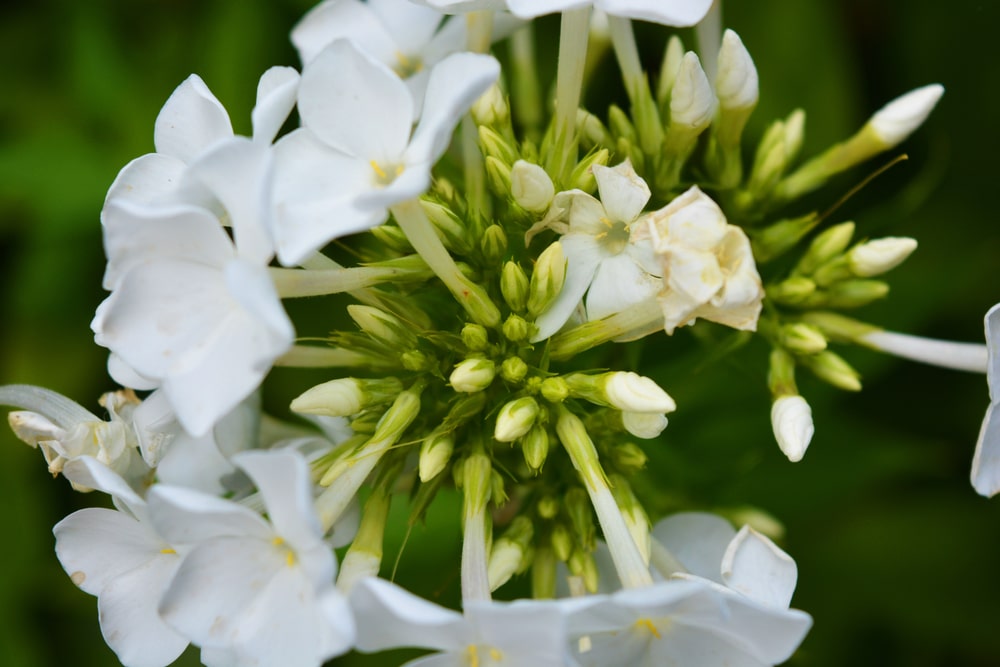
Some varieties:
- White Creeping Phlox (Phlox subulata ‘Spring White’)
- Tall Garden Phlox (Phlox paniculata ‘Backlight’)
- Tall Garden Phlox (Phlox paniculata ‘David’)
Whether you’re looking for the spring-blooming, low-growing ground cover of white creeping phlox, or any of the later-blooming tall garden varieties, phlox is a staple in many gardens with good reason.
Beautiful and relatively unfussy, phlox is commonly used as a border plant in perennial plantings.
It is fragrant, the tall varieties can be used as cut flowers, and regardless of the variety you choose, masses of flowers will encourage hummingbirds and butterflies to drop by.
Creeping varieties stay within 8 inches (20.32 centimeters) of the ground and can be easily encouraged to trail over edges. These varieties typically bloom in spring as carpets of white flowers.
Tall varieties can bloom for six weeks or more. Some will begin blooming in June, while others wait until August. You can choose varieties to stagger blooms for a longer show. They can reach 2 or 3 feet (0.60 – 0.91 meters) in height.
2 – White Stonecrop (Sedum album)
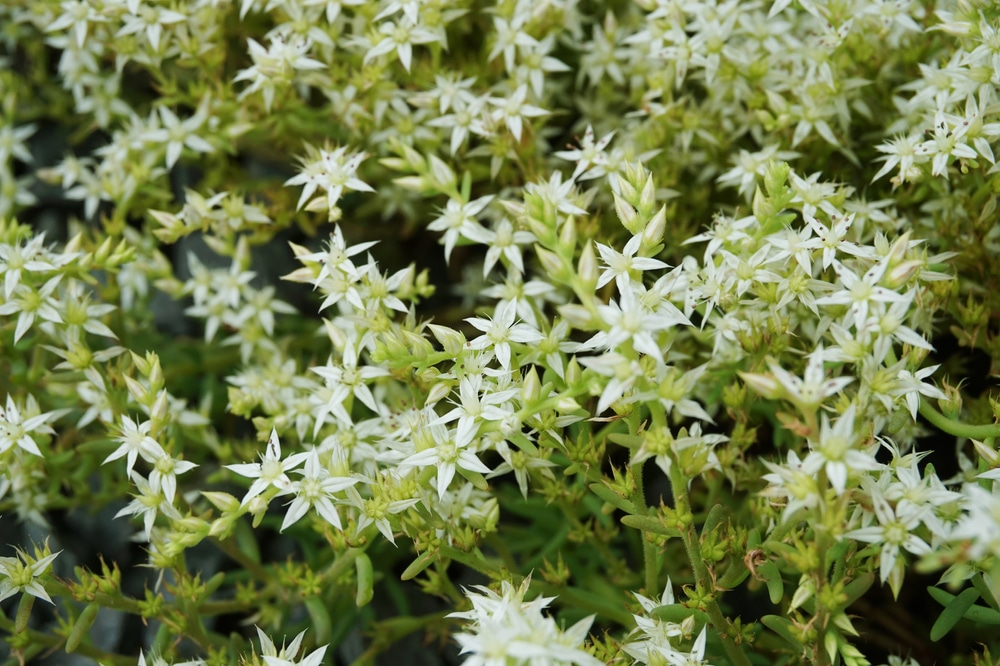
White stonecrop is a dense evergreen succulent that can thrive in a surprising array of environments. It even tolerates light foot traffic if you plant it between stones in a pathway.
A fairly slow grower, white stonecrop’s value lies most in its uniqueness and ability to thrive where other plants can’t.
This sedum can overwinter in zones as cold as 3 and thrives in dry areas with poor-quality or even rocky soils as long as it receives full sun. It will tolerate some shade but will not bloom as profusely.
White stonecrop foliage changes color depending on the amount of water it receives. It is green with ample water and turns reddish-brown when water is less abundant.
The tiny, star-shaped flowers form in clusters on stems just above the foliage at 4 inches (10.16 centimeters) and last through July and August.
3 – Western Yarrow (Achillea millefolium var. occidentalis)
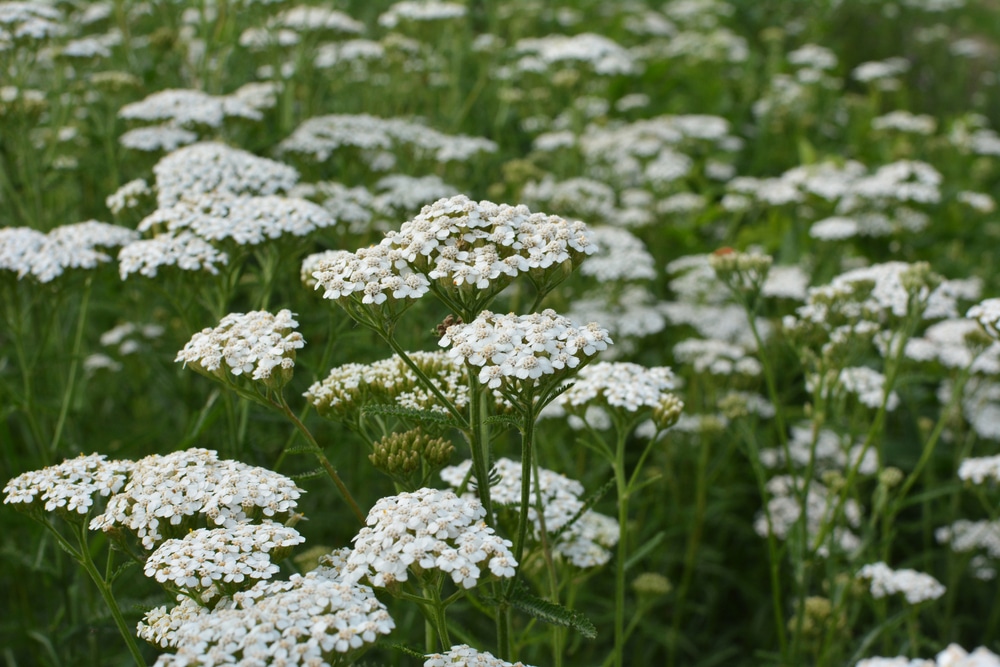
Western yarrow is a hardy wildflower native to all of North America. It easily grows in a wide range of conditions in USDA hardiness zones 2-9. It will grow successfully in low- or high-quality soils and can tolerate extremely dry environments, though it does require full sun to be at its best.
Between its mounding, feathery foliage and long-lasting blooms, yarrow is an attractive plant for gardeners and pollinators alike.
Attractive to predatory wasps, hoverflies, and ladybugs, some gardeners like to plant yarrow among food crops to attract predators of insects that could threaten production.
Flowering happens early in May and lasts until the end of the growing season in September or October. Plants are 10-36 inches tall (25.40-91.44 centimeters).
4 – Hydrangea
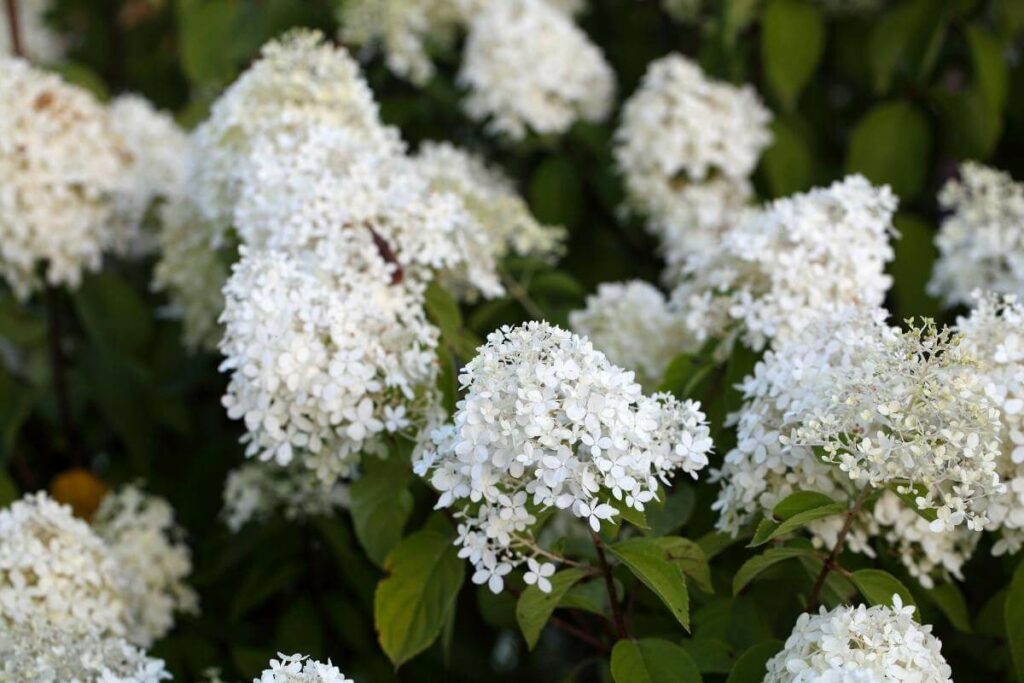
Some varieties:
- Hydrangea paniculata ‘Limelight’
- Hydrangea paniculata ‘Renba’ (Berry white)
- Hydrangea arborescens ‘Annabelle’
Hydrangeas are woody flowering shrubs in a vast array of sizes, shapes, and colors. Whether you want to grow them in large hedgerows, as a vine, in a bed as an accent, or even in a container, without a doubt, there is a hydrangea for every garden.
Hydrangeas can live for decades if planted well, pruned, fed, and watered appropriately. Depending on the variety, they can grow 7 feet tall (2.13 meters) and spread to 5 feet wide (1.52 meters).
You can plant hydrangeas in full sun to partial shade, though they tend to prefer moderate conditions in all respects. They can become stressed and wilt if sun exposure is too intense but won’t flower as vigorously if planted in too much shade. They will not tolerate drought. You need to water them well and mulch if they must tolerate extended periods of cold in the winter.
H. paniculata varieties feature white, conical flowers that can become tinged with pink as the season moves on. They are hardy from USDA hardiness zones 3-8.
H. arborescens varieties are also known as smooth hydrangeas. ‘Annabelle’ is a very common variety and features huge globe-sized, white blossoms.
Most varieties begin blooming in late spring or early summer and continue for a couple of months, some into the fall.
5 – Astilbe
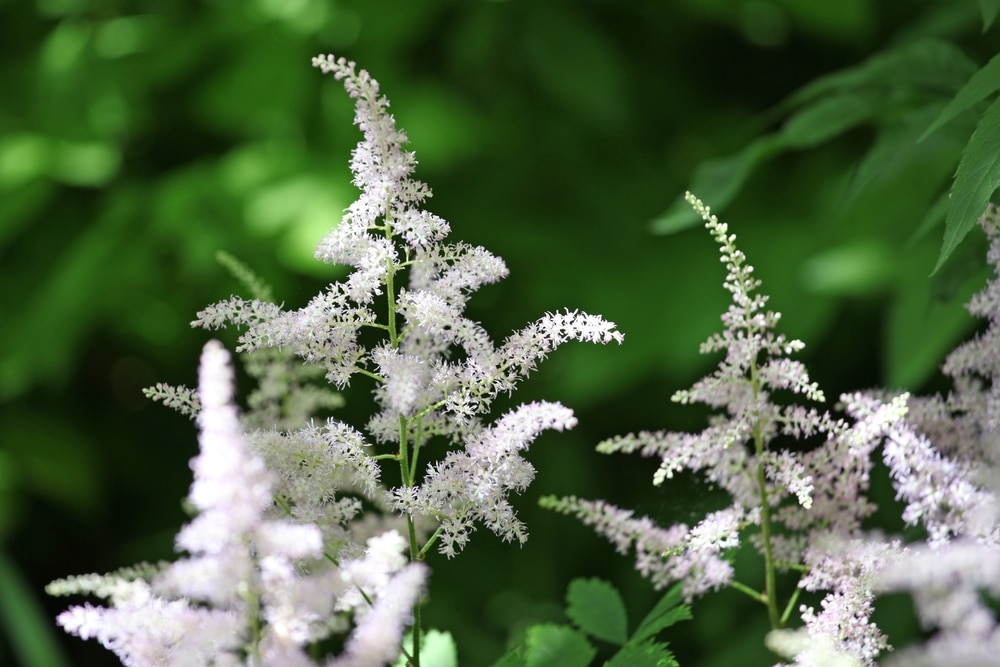
Some varieties:
- Astilbe chinensis ‘Vision in White’
- Astilbe x arendsii ‘Bridal Veil’
I discovered astilbe when I planted my first shade garden. I still grow it and commonly recommend it for shadier plantings, though it does flower best with a little bit of sun.
It is a hardy perennial and will happily live in gardens between USDA hardiness zones 3-8.
There is a wide variety of astilbes, even among only the white blooming cultivars, each featuring different heights and bloom times. The most compact varieties stay at approximately 10 inches (25.40 centimeters), and the largest can have flowers reaching 4 feet (1.21 meters).
Some flower in May and others in July. Blooms last for approximately three weeks (this depends on weather conditions from year to year). Planting a few different astilbes can lengthen the blooming window.
You can cut the flowers for arrangements, and they should last in a vase for about a week. They also dry nicely. That said, once cut, they will not rebloom until the following season.
6 – Lily

Some varieties:
- Lilium asiatic ‘Happy Ice’
- Lilium regale ‘Album’
Martagon, Asiatic, and oriental hybrids are just three of the several categories of lily types. Suffice it to say there are a lot of lilies, thousands of them.
Lilies need to be planted in well-draining soil. Though they don’t take up much space in the garden, their foliage needs plenty of sun. Tall varieties (some growing up to 6 feet (1.82 meters)) may need to be staked or otherwise given support.
The entire range of lilies are beautiful, and most feature scented flowers that will attract hummingbirds, butterflies and bees.
When they bloom depends on the variety. Some cultivars start to bloom in early to midsummer, while others need until August.
Border lilies, such as L. Asiatic ‘Happy Ice’, are medium-height and great for dressing up a border or pots. They grow in USDA hardiness zones 3 -8 and reach a height of 14-18 inches (35.56-45.72 centimeters).
L. regale ‘Album’ is a regal lily, which can grow to 6 feet (1.82 meters) and features up to 25 trumpet-shaped blossoms on each stem. It blooms at the early end of the growing season.
Each plant blooms for about 2-3 weeks. If you were to choose a few varieties that flower at different times, you could have a staggered planting that lasts all summer.
7 – Rose
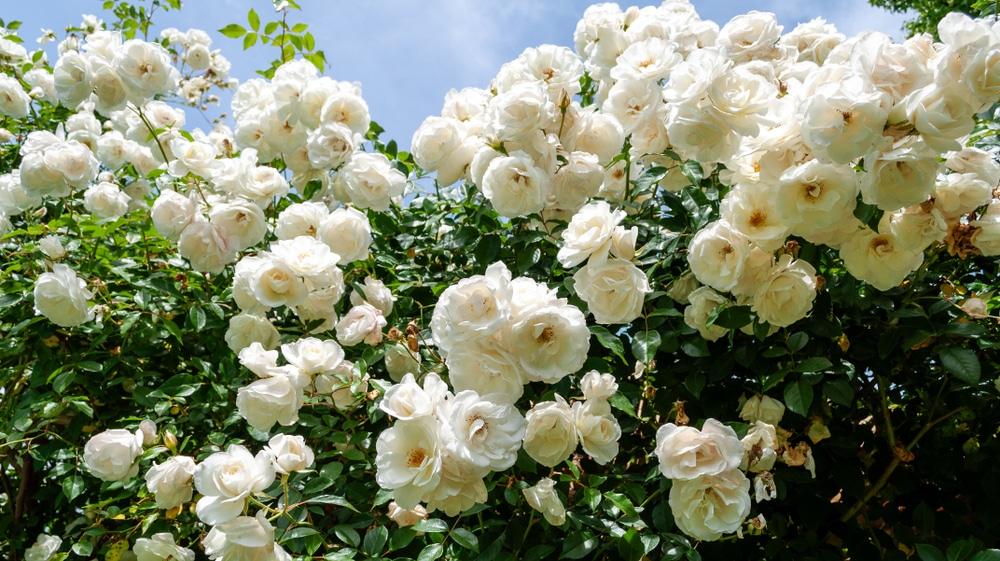
Some varieties:
- Rosa ‘Iceberg’
- Rosa ‘City of York’
Roses are the quintessential garden flower for many. Lovely, fragrant, and storied – they’re hard not to like. They also have somewhat of a reputation for being fussy.
While commonly held ideas about growing roses are not altogether unwarranted, it is important to note that this plant has been cultivated for a very long time. There are thousands of roses, ranging from very low-maintenance plants to more difficult plants.
Almost all roses can be grown in zones 6, 7, and 8 – others have been adapted to slightly colder and warmer climes.
Roses need plenty of sun, rich, nutritious soil, and consistent watering to be at their best.
Some types of roses bloom continuously from late May until the beginning of autumn, while others will set flowers once during the season, their blooms lasting as long as they last.
Rosa ‘Iceberg’ is a floribunda rose. It is a 3-foot (0.91-meter) shrub that produces a fabulous show of flowers from May until autumn. However, it doesn’t have much of a scent.
Rosa ‘City of York’ is a fragrant, profusely flowering, hardy climbing rose that can be 15 feet (4.57 meters) at maturity. It flowers once between June and July.
8 – Hosta
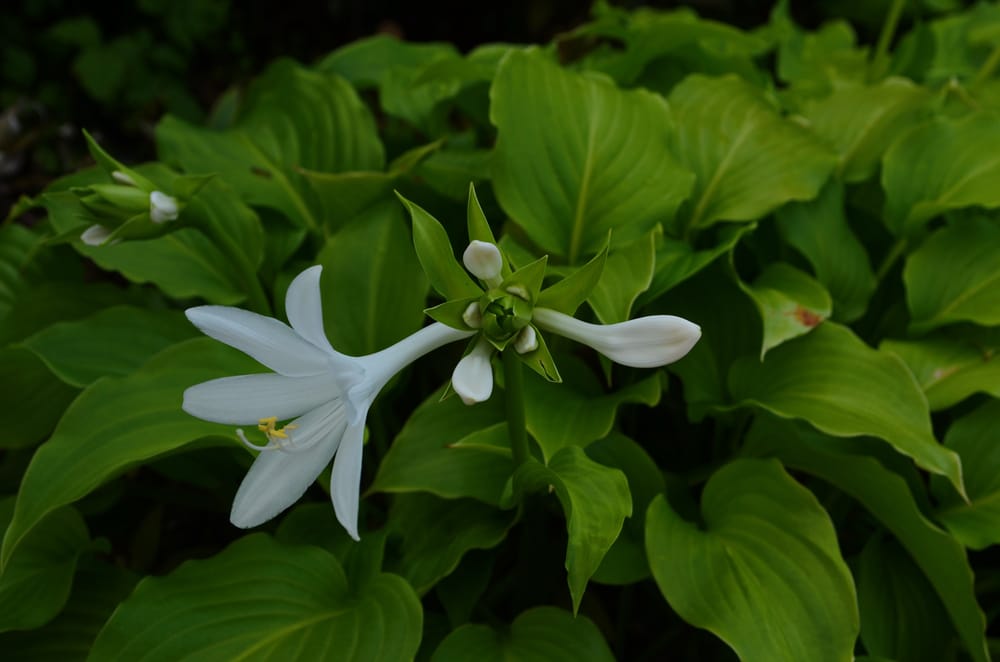
Some varieties:
- Hosta undulata ‘White Feather’
- Hosta plantaginea ‘Aphrodite’
- Hosta plantaginea ‘Venus’
Hostas are a great perennial addition to so many different spaces but are often included for the lushness and patterned beauty of their leaves.
Make no mistake, hostas are not just a foliage plant! Hosta flowers can make a splendid display. By choosing a variety of cultivars, you can have hostas in bloom from May to the end of the season.
The two H. plantaginea varieties I am recommending bloom later in the summer and flowers open later in the day, instead of in the morning as is typical. These hostas grow most successfully with partial or even full sun.
H. undulata is included here due to its unusual white leaves. A small, compact plant, ‘White Feather’ foliage emerges a creamy white color. As the summer progresses, they do become more green.
9 – Peony
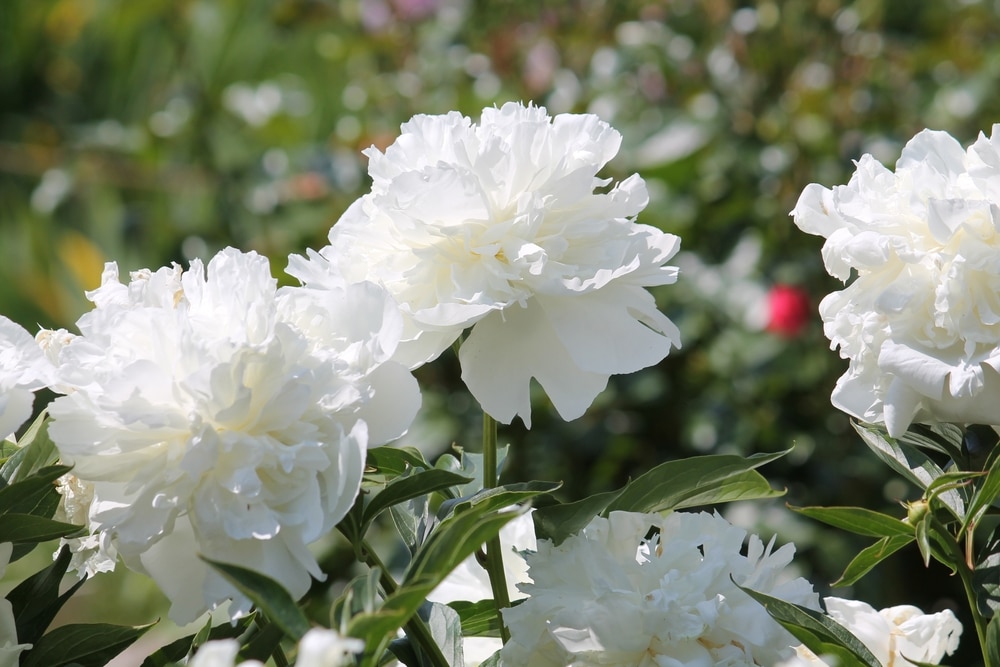
Some varieties:
- Peony lactiflora ‘Petite Porcelain’
- Peony lactiflora ‘Duchess of Nemours’
Fragrant peonies are gorgeous and beloved sun-loving perennials. They grow in USDA hardiness zones 3-8 and like to be planted in rich, well-draining soil.
Lasting just 7-10 days, the flowers bloom for a relatively short period.
Truthfully, peony plants can be a little bit finicky to get established. A friend of mine once waited five years before she was able to get one of her favorites to bloom in her home garden.
So, why am I including peony in this list?
Because they are truly magnificent.
Planting different varieties can extend the blooming window. Depending on where you are gardening, early-season peonies will begin flowering in May, mid-season varieties in June, and late-season cultivars in July.
Peonies need physical support to remain upright. Grow-through supports are best. Install them in early spring so emerging foliage can grow through.
Be careful not to plant the crown of the plant any deeper than 2 inches (5.08 centimeters) deep. Doing so can result in plenty of foliage but no flowers.
White peonies are often among the most fragrant.
10 – Delphinium
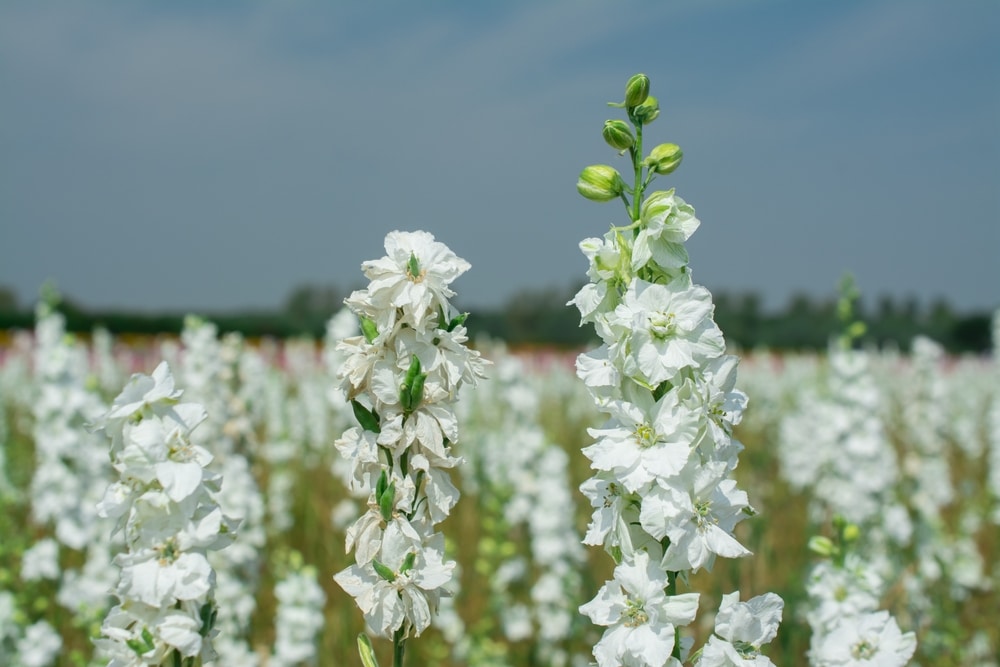
Some varieties:
- Delphinium elatum ‘Guardian White’
- Delphinium elatum ‘Magic Fountains Pure White’
- Delphinium elatum ‘Aurora White’
Nothing conjures the image of a cottage garden quite like a stand of delphinium flowers. Tall, showy spikes with many blossoms on each stem, they are the true definition of stunning.
Delphiniums thrive in full sun, rich soil, and good drainage. They are quite hardy and will happily live in USDA hardiness zones 3-8.
At between 5 feet (1.52 meters) to 6.5 feet (1.98 meters) when fully grown, delphiniums do need some shelter and support from wind and storms. Plant them next to walls or fences or add stakes.
Most varieties bloom in June or July for several weeks. If you remove the flowers once they are waning, you should be rewarded with another round of blooms later in the season.
Commonly referred to as larkspur, delphinium and larkspur are often confused. While the two are botanical cousins and look quite similar, most delphiniums are perennial, and most larkspurs are annuals.

